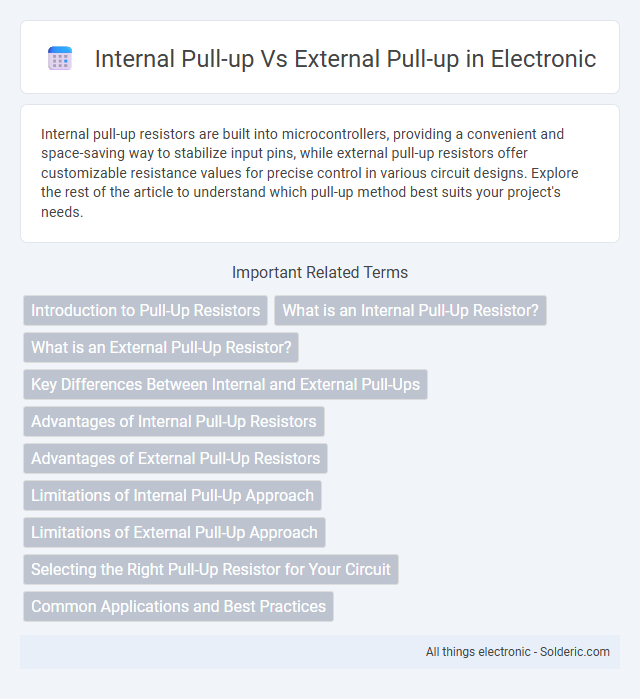Internal pull-up resistors are built into microcontrollers, providing a convenient and space-saving way to stabilize input pins, while external pull-up resistors offer customizable resistance values for precise control in various circuit designs. Explore the rest of the article to understand which pull-up method best suits your project's needs.
Comparison Table
| Aspect | Internal Pull-up | External Pull-up |
|---|---|---|
| Definition | Built-in resistor inside microcontroller | Physically added resistor on the circuit board |
| Resistance Value | Fixed, typically 20k-50k O | Customizable, usually 1k-10k O |
| Usage | Simple circuits, limited control | Flexible, for precise current control |
| Power Consumption | Higher due to larger resistance | Lower with optimized resistor choice |
| Signal Integrity | Less optimal for fast signals | Better for high-speed or noise-sensitive signals |
| Board Complexity | Reduced, no extra components | Increased, additional resistor needed |
| Cost | Lower, no external part | Higher due to extra resistor |
Introduction to Pull-Up Resistors
Pull-up resistors maintain a defined voltage level on a digital input pin, preventing it from floating and causing unpredictable behavior. Internal pull-up resistors, integrated within microcontrollers, offer convenience and save space but have fixed resistance values, typically between 20k to 50k ohms. External pull-up resistors provide flexibility in choosing precise resistance values to optimize current consumption and signal integrity based on your circuit requirements.
What is an Internal Pull-Up Resistor?
An internal pull-up resistor is a built-in resistor within a microcontroller or digital input pin that connects the input line to a positive voltage supply, typically Vcc, to ensure a defined logic high state when no external signals are applied. It eliminates the need for an external resistor on the PCB, simplifying circuit design and reducing component count. Internal pull-ups typically range between 20 kO to 50 kO, providing sufficient current limitation while maintaining stable input readings in digital circuits.
What is an External Pull-Up Resistor?
An external pull-up resistor is a discrete component connected between a microcontroller input pin and a positive voltage supply to ensure a defined logic high level when no active device is driving the line. This resistor prevents floating inputs, reducing noise and improving signal stability in digital circuits. Your circuit design may require an external pull-up resistor when the internal pull-up option does not provide the needed resistance or when precise control over the current and voltage levels is essential.
Key Differences Between Internal and External Pull-Ups
Internal pull-ups are integrated resistors within microcontroller pins, typically ranging from 20kO to 50kO, and provide a convenient, space-saving solution with limited current sinking capabilities. External pull-ups consist of discrete resistors, often between 4.7kO and 10kO, offering precise control over resistance value for faster signal rise times and improved noise immunity in demanding applications. Choosing between internal and external pull-ups depends on desired electrical characteristics, speed requirements, and environmental noise conditions.
Advantages of Internal Pull-Up Resistors
Internal pull-up resistors simplify circuit design by eliminating the need for extra external components, saving both space and cost on your PCB. They provide reliable default logic levels by weakly pulling input pins to a high state, reducing susceptibility to noise and floating inputs. Utilizing internal pull-ups enhances assembly efficiency and minimizes wiring complexity in digital input configurations.
Advantages of External Pull-Up Resistors
External pull-up resistors offer precise control over resistance values, enabling designers to select optimal resistance for specific circuit requirements and improve current consumption management. These resistors provide enhanced noise immunity and signal integrity in environments with high electrical interference, ensuring reliable digital input readings. Additionally, external pull-ups facilitate easier debugging and modifications in circuit design, as they can be replaced or adjusted without altering the integrated circuit.
Limitations of Internal Pull-Up Approach
Internal pull-up resistors in microcontrollers typically have higher resistance values, often between 20 kO and 50 kO, which limits their effectiveness in noise-prone environments or when driving multiple inputs. These resistors offer less precise control over the pull-up strength, making external pull-up resistors preferable for applications requiring exact current or voltage specifications. Using internal pull-ups can result in slower signal rise times and increased susceptibility to electromagnetic interference compared to external pull-up resistors.
Limitations of External Pull-Up Approach
External pull-up resistors can introduce increased power consumption and occupy additional PCB space, potentially complicating the circuit design. Their fixed resistance values may limit flexibility and responsiveness in dynamic conditions, impacting signal integrity and timing. Your design efficiency can suffer as these resistors add cost and complexity compared to integrated internal pull-ups.
Selecting the Right Pull-Up Resistor for Your Circuit
Selecting the right pull-up resistor for your circuit depends on balancing power consumption, signal stability, and noise immunity. Internal pull-up resistors offer convenience and reduce component count but have higher resistance values (typically 20-50 kO), which can lead to slower signal transitions and susceptibility to noise. External pull-up resistors provide flexibility with lower resistance options (1 kO to 10 kO), enhancing speed and noise performance, especially in environments with longer wires or higher interference levels.
Common Applications and Best Practices
Internal pull-ups are commonly used in microcontroller input pins for simple switch or button interfaces where space and component count must be minimized. External pull-up resistors are preferred in high-noise environments or when precise control over the resistor value is required, such as in I2C communication lines. You should select external pull-ups for improved signal integrity and flexibility in sensor or bus applications, following manufacturer guidelines for resistor value based on the specific device and bus speed.
Internal pull-up vs External pull-up Infographic

 solderic.com
solderic.com